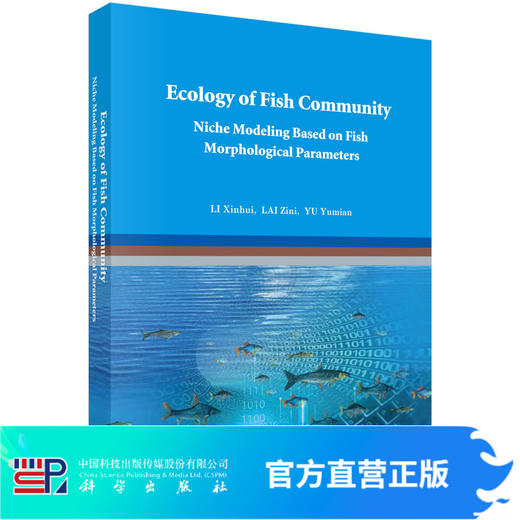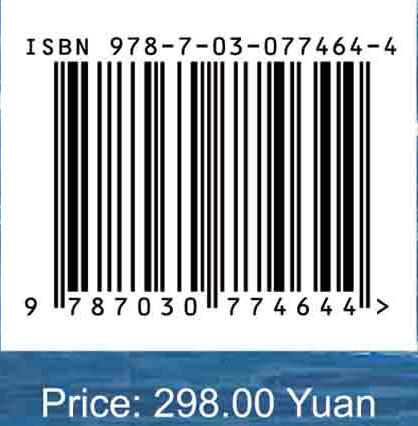Ecology of Fish Community Niche Modeling Based on Fish Morphological Parameters(鱼类形态学模型与群落研究)
¥235.40
| 运费: | ¥ 0.00-18.00 |
商品详情
书名:Ecology of Fish Community Niche Modeling Based on Fish Morphological Parameters(鱼类形态学模型与群落研究)
定价:298.0
ISBN:9787030774…4
作者:李新辉,赖子尼,余煜棉
版次:1
出版时间:2024-05
内容提要:
本书是关于利用形态学模型解构分析江河鱼类群落的专著。长期进化过程中,鱼类在与环境(包括鱼类之间)相互作用下,形成形态各异的种类,占据各自的生态位,组成鱼类群落。本书以鱼类群落为对象,通过物种的形态学性状,建立了一种“基于形态学性状”的鱼类群落研究模型。通过开发软件和案例分析,从生态位角度研究鱼类群落种间的关系,并以河流生态修复服务为目标,试图为鱼类群落构建提供一种辅助分析工具。
目录:
Contents
Preface
Introduction
CHAPTER 1 Fish Communities and River Ecosystems 1
1.1 Species 4
1.1.1 Species Clasification 4
1.1.2 Fish 5
1.1.3 Morphological Characters for Classification 5
1.2 Community 8
1.2.1 Composition 8
1.2.2 Proportion 9
1.2.3 Structure 9
1.2.4 Community Habitat 9
1.2.5 Environment 9
1.2.6 Ecological Characters 10
1.2.7 Spatial Pattern 10
1.2.8 Temporal Characteristics 10
1.3 Niche 10
1.3.1 Ideal Niche 11
1.3.2 Real Niche 12
1.3.3 Conservation 12
1.3.4 Multidimensionality 12
1.3.5 Overlap 12
1.3.6 Niche Breadth 12
1.3.7 Ecological Equivalents 12
1.3.8 Coincident Species 13
1.3.9 Species Evolution and Niche 13
1.4 River Ecosystem Elements 13
1.4.1 Water Chemistry 14
1.4.2 Water Quality 14
1.4.3 Aquatic Life 15
1.4.4 Organic Detritus 16
1.4.5 Productivity of Water Bodies 16
1.4.6 Trophic Level 17
1.4.7 Natural Balance 17
1.4.8 Water Pollution 17
1.4.9 Algal Blooms 17
1.5 Freshwater Fish 18
1.5.1 Global Freshwater Fish Communities 18
1.5.2 Community Characteristics of Freshwater Fish in China 20
CHAPTER 2 Fish Morphological Models and Mechanisms 25
2.1 Multivariate Statistics 28
2.1.1 Regression Analysis 29
2.1.2 Linear Discriminant Analysis 29
2.1.3 Cluster Analysis 29
2.1.4 Principal Component Analysis (PCA) 30
2.1.5 Correspondence Analysis 30
2.1.6 Factor Analysis 30
2.1.7 Canonical Correlation Analysis 30
2.2 Morphological Data Model 31
2.2.1 Data Source 32
2.2.2 Data Matrix 32
2.2.3 Principles of the Correspondence Analysis Model 36
2.2.4 Contribution to Variance 37
2.2.5 Graph Representation of the Interspecific Relationships Within Fish Communities 38
2.3 The Model 42
2.3.1 Species Relationship Model 45
2.3.2 Character Fitness 50
2.3.3 Applicability of New Species 50
2.4 Examples of Model Application 51
2.4.1 Characterization of Community Specics Relationships 51
2.4.2 Determining the Ideal Niche 56
2.43 Iteration 62
2.4.4 Sample Iteration Order …
2.4.5 Sample Iteration Constraints 65
2.4.6 Sample Normalization 65
2.4.7 Model Checking 65
2.4.8 Model Workflow 65
2.4.9 Model Application and Limitations 67
2.5 The Modeling Software 69
2.5.1 Data File and Editing 69
2.5.2 Run 71
CHAPTER 3 Relationship Between Community Structure and Species Sucession 73
3.1 Simulations of Species Removal 76
3.1.1 Osmeriformes Lcucosoma chinensis (Osbeck, 1765) 77
3.1.2 Cyprinifome 77
3.1.3 Siluriformes, Bagridae 188
3.1.4 Perciformes 198
3.1.5 Tetraodontiformes 208
3.2 Simulated Community 208
3.2.1 Niche Composition 208
3.2.2 Niche Chang 212
CHAPTER 4 Relationship Between Community Niche and Succession 217
4.1 Characteristics of Community Stabilit 219
4.1.1 Species Substitutability 223
4.1.2 Community Cohesion 223
4.1.3 Community Integration 226
4.1.4 Characteristics of the Geographic Distribution of the Ecological Niche Response 232
4.1.5 Differences 239
4.1.6 Feeding Habits 245
4.2“Subunit Community" Succession 250
4.2.1 Niche Changes in the "Subunit Comrmunity" 254
4.2.2 Simulated Community Performance After Species Removal 285
4.2.3 The Evolutionary Characteristics of the“Subunit Communities" 290
CHAPTER 5 Fish Community Reconstruction and Case Study 299
5.1 River Ecosystems 300
5.1.1 River Structure 301
5.1.2 River Ecological Function 302
5.1.3 Composition of the Fish Diet 304
5.1.4 Fish Trophic Levels 310
5.2 Molecular Mechanisms of Energy Utilization and Ecological Niche 318
5.2.1 Fish Amylase 319
5.2.2 Gene Sequence and Niche 321
5.2.3 Amylase Gene Transcription and Animal Feeding Habits 322
5.3 Species Selection for Community Construction 323
5.3.1 Multispecies Model 328
5.3.2 The Food Chain is Fully Functional 330
5.3.3 Species Compatibility 332
5.4 Examples of Model Applcatio 335
5.4.1 Relationship Between Model “Potential" and Comrmunity 335
5.4.2 Environmental Impact Analysis Reference Frame 339
5.4.3 Analysis of the Niche of the Artificial Community 341
References 343
定价:298.0
ISBN:9787030774…4
作者:李新辉,赖子尼,余煜棉
版次:1
出版时间:2024-05
内容提要:
本书是关于利用形态学模型解构分析江河鱼类群落的专著。长期进化过程中,鱼类在与环境(包括鱼类之间)相互作用下,形成形态各异的种类,占据各自的生态位,组成鱼类群落。本书以鱼类群落为对象,通过物种的形态学性状,建立了一种“基于形态学性状”的鱼类群落研究模型。通过开发软件和案例分析,从生态位角度研究鱼类群落种间的关系,并以河流生态修复服务为目标,试图为鱼类群落构建提供一种辅助分析工具。
目录:
Contents
Preface
Introduction
CHAPTER 1 Fish Communities and River Ecosystems 1
1.1 Species 4
1.1.1 Species Clasification 4
1.1.2 Fish 5
1.1.3 Morphological Characters for Classification 5
1.2 Community 8
1.2.1 Composition 8
1.2.2 Proportion 9
1.2.3 Structure 9
1.2.4 Community Habitat 9
1.2.5 Environment 9
1.2.6 Ecological Characters 10
1.2.7 Spatial Pattern 10
1.2.8 Temporal Characteristics 10
1.3 Niche 10
1.3.1 Ideal Niche 11
1.3.2 Real Niche 12
1.3.3 Conservation 12
1.3.4 Multidimensionality 12
1.3.5 Overlap 12
1.3.6 Niche Breadth 12
1.3.7 Ecological Equivalents 12
1.3.8 Coincident Species 13
1.3.9 Species Evolution and Niche 13
1.4 River Ecosystem Elements 13
1.4.1 Water Chemistry 14
1.4.2 Water Quality 14
1.4.3 Aquatic Life 15
1.4.4 Organic Detritus 16
1.4.5 Productivity of Water Bodies 16
1.4.6 Trophic Level 17
1.4.7 Natural Balance 17
1.4.8 Water Pollution 17
1.4.9 Algal Blooms 17
1.5 Freshwater Fish 18
1.5.1 Global Freshwater Fish Communities 18
1.5.2 Community Characteristics of Freshwater Fish in China 20
CHAPTER 2 Fish Morphological Models and Mechanisms 25
2.1 Multivariate Statistics 28
2.1.1 Regression Analysis 29
2.1.2 Linear Discriminant Analysis 29
2.1.3 Cluster Analysis 29
2.1.4 Principal Component Analysis (PCA) 30
2.1.5 Correspondence Analysis 30
2.1.6 Factor Analysis 30
2.1.7 Canonical Correlation Analysis 30
2.2 Morphological Data Model 31
2.2.1 Data Source 32
2.2.2 Data Matrix 32
2.2.3 Principles of the Correspondence Analysis Model 36
2.2.4 Contribution to Variance 37
2.2.5 Graph Representation of the Interspecific Relationships Within Fish Communities 38
2.3 The Model 42
2.3.1 Species Relationship Model 45
2.3.2 Character Fitness 50
2.3.3 Applicability of New Species 50
2.4 Examples of Model Application 51
2.4.1 Characterization of Community Specics Relationships 51
2.4.2 Determining the Ideal Niche 56
2.43 Iteration 62
2.4.4 Sample Iteration Order …
2.4.5 Sample Iteration Constraints 65
2.4.6 Sample Normalization 65
2.4.7 Model Checking 65
2.4.8 Model Workflow 65
2.4.9 Model Application and Limitations 67
2.5 The Modeling Software 69
2.5.1 Data File and Editing 69
2.5.2 Run 71
CHAPTER 3 Relationship Between Community Structure and Species Sucession 73
3.1 Simulations of Species Removal 76
3.1.1 Osmeriformes Lcucosoma chinensis (Osbeck, 1765) 77
3.1.2 Cyprinifome 77
3.1.3 Siluriformes, Bagridae 188
3.1.4 Perciformes 198
3.1.5 Tetraodontiformes 208
3.2 Simulated Community 208
3.2.1 Niche Composition 208
3.2.2 Niche Chang 212
CHAPTER 4 Relationship Between Community Niche and Succession 217
4.1 Characteristics of Community Stabilit 219
4.1.1 Species Substitutability 223
4.1.2 Community Cohesion 223
4.1.3 Community Integration 226
4.1.4 Characteristics of the Geographic Distribution of the Ecological Niche Response 232
4.1.5 Differences 239
4.1.6 Feeding Habits 245
4.2“Subunit Community" Succession 250
4.2.1 Niche Changes in the "Subunit Comrmunity" 254
4.2.2 Simulated Community Performance After Species Removal 285
4.2.3 The Evolutionary Characteristics of the“Subunit Communities" 290
CHAPTER 5 Fish Community Reconstruction and Case Study 299
5.1 River Ecosystems 300
5.1.1 River Structure 301
5.1.2 River Ecological Function 302
5.1.3 Composition of the Fish Diet 304
5.1.4 Fish Trophic Levels 310
5.2 Molecular Mechanisms of Energy Utilization and Ecological Niche 318
5.2.1 Fish Amylase 319
5.2.2 Gene Sequence and Niche 321
5.2.3 Amylase Gene Transcription and Animal Feeding Habits 322
5.3 Species Selection for Community Construction 323
5.3.1 Multispecies Model 328
5.3.2 The Food Chain is Fully Functional 330
5.3.3 Species Compatibility 332
5.4 Examples of Model Applcatio 335
5.4.1 Relationship Between Model “Potential" and Comrmunity 335
5.4.2 Environmental Impact Analysis Reference Frame 339
5.4.3 Analysis of the Niche of the Artificial Community 341
References 343
- 科学出版社旗舰店 (微信公众号认证)
- 科学出版社秉承多年来形成的“高层次、高水平、高质量”和“严肃、严密、严格”的优良传统与作风,始终坚持为科技创新服务、为传播与普及科学知识服务、为科学家和广大读者服务的宗旨。
- 扫描二维码,访问我们的微信店铺
- 随时随地的购物、客服咨询、查询订单和物流...





![[按需印刷]心理语言学/杨玉芳](https://img01.yzcdn.cn/upload_files/2022/06/11/FtfVtycQKLdBjVl0Z-N1lTKU_JZw.jpg?imageView2/2/w/260/h/260/q/75/format/jpg)






